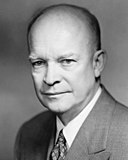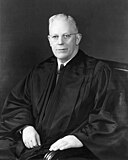1952 Republican Party presidential primaries
From March 11 to June 3, 1952, delegates were elected to the 1952 Republican National Convention.
| |||||||||||||||||||||||||||||||||||||||||||||||
1,206 delegates to the 1952 Republican National Convention 604 (majority) votes needed to win | |||||||||||||||||||||||||||||||||||||||||||||||
|---|---|---|---|---|---|---|---|---|---|---|---|---|---|---|---|---|---|---|---|---|---|---|---|---|---|---|---|---|---|---|---|---|---|---|---|---|---|---|---|---|---|---|---|---|---|---|---|
| |||||||||||||||||||||||||||||||||||||||||||||||
Eisenhower Taft Stassen Warren | |||||||||||||||||||||||||||||||||||||||||||||||
| |||||||||||||||||||||||||||||||||||||||||||||||
The fight for the 1952 Republican nomination was largely between popular General Dwight D. Eisenhower (who succeeded Thomas E. Dewey as the candidate of the party's liberal eastern establishment) and Senator Robert A. Taft of Ohio, the longtime leader of the conservative wing. Foreign policy during the Cold War was a major point of contention, with Eisenhower taking an interventionist stance and Taft favoring greater caution and avoidance of foreign alliances. Eisenhower tended to accept many of the social welfare aspects of the New Deal, to which Taft was adamantly opposed.
Two other major candidate for the nomination, though never challenging Eisenhower or Taft, were Governor of California and Dewey's 1948 running-mate Earl Warren, and former Governor of Minnesota Harold Stassen, who had contended for the nomination in 1948 as well.
Taft, who was 62 when the campaign began and running his third presidential campaign, freely admitted that this would be his last chance to win the nomination. Taft's weakness, which he was never able to overcome, was the fear of many party bosses that he was too conservative and controversial to win a presidential election.[citation needed] The primaries were ultimately inconclusive, and the nomination was decided by a contest over delegates from Texas and Georgia; led by Dewey and Henry Cabot Lodge Jr., the Eisenhower campaign won a vote of the whole convention to award the contested delegates to Eisenhower, who carried the first ballot. The episode was reminiscent of the 1912 Republican National Convention forty years prior, where Taft's father won the nomination over Theodore Roosevelt by similar means.
In the general election on November 4, Eisenhower and his running mate, Senator Richard Nixon of California, defeated the Democratic party's ticket of Governor Adlai Stevenson II of Illinois, and Senator John Sparkman of Alabama.
Background
Beginning in 1932, during a period which political historians would later call the "Fifth Party System," United States politics were dominated by the Democratic Party and its New Deal coalition of laborers and labor organizations, racial and religious minorities (especially Jews, Catholics, and African Americans), liberal white Southerners, and intellectuals. delivered consistent victories for the Democratic Party at the presidential and congressional level. Entering the 1952 election campaign, no Republican had been elected president since Herbert Hoover in 1928. Republicans had only won a single national election during the period, in the 1946 elections to the 80th United States Congress.
1948 presidential election
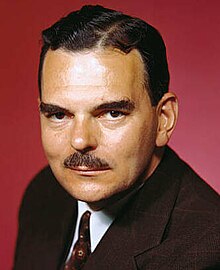
Following their victory in 1946, Republicans were hopeful to win back the White House in 1948. With the progressive and Southern wings of the Democratic Party bolting from the presidential ticket and popular Governor of New York Thomas E. Dewey leading their ticket for the second consecutive campaign, most expected a Republican victory but were surprised by the re-election of President Harry S. Truman in one of the biggest upsets in the history of presidential elections.
Having lost the presidency three times, Dewey declined to make a fourth run. Instead, the leading candidates were Dewey's main rivals for the 1948 nomination, Senator Robert A. Taft of Ohio and former Governor Harold Stassen of Minnesota, and his 1948 running mate, Governor of California Earl Warren.
Draft Eisenhower movement
During the 1948 campaign, James Roosevelt and Americans for Democratic Action attempted to draft popular World War II general Dwight D. Eisenhower, then Chief of Staff of the Army, to replace President Truman on the Democratic Party ticket. Eisenhower, who commanded the Allied Expeditionary Force in the invasions of Normandy and Germany, remained broadly popular and admired across the country without regard for political position or region.[1] However, Eisenhower repeatedly declined to seek the Democratic nomination ahead of the 1948 convention and issued a Shermanesque statement removing himself from consideration on July 5, 1948.[2] Repeated efforts to ignore his statement failed when Roosevelt admitted that a draft would not succeed to convince Eisenhower, and the party nominated Truman instead.
By 1951, with Truman's popularity polling at record lows, both parties attempted to draft Eisenhower once again. However, since the 1948 election, he had been increasingly drawn toward the Republican Party.[3] Dewey and Senator Henry Cabot Lodge Jr. of Massachusetts led efforts to convince Eisenhower to run as a Republican and, through a series of organizations financed and led by Charles F. Willis, Stanley M. Rumbough Jr., and Harold E. Talbott, established a draft effort with over 250,000 members nationwide.[4][5][6][7] Personal friends and former military colleagues were also involved in the Republican draft effort.[7] They were motivated at least partly by Eisenhower's broad appeal, which they felt Stassen and Taft lacked, and his support for post-war international organizations like the United Nations and North Atlantic Treaty Organization, which Taft opposed or supported to a more limited extent than Eisenhower. With Taft leading the field in late 1951, Eisenhower's reluctance to run declined, and on January 6, 1952, he permitted Lodge to publicly reveal that he considered himself a Republican.[8]
Candidates
The following leaders were candidates for the 1952 Republican presidential nomination:
Major candidates
These candidates participated in multiple state primaries or were included in multiple major national polls.
| Candidate | Most recent position | Home state | Campaign | |
|---|---|---|---|---|
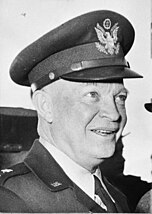 | Supreme Allied Commander of NATO (1951–1952) President of Columbia University (1948–1953) |  Kansas Kansas | 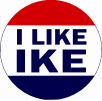 Accepted draft: June 4, 1952[9] Nominated at convention: July 11, 1952 (Campaign) | |
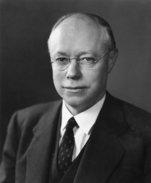 | United States Senator from Ohio (1939–1953) Ohio State Senator (1931–1933) Speaker of the Ohio House of Representatives (1926–1927) |  Ohio Ohio | Announced campaign: October 16, 1951[10] Defeated at convention: July 11, 1952 (Campaign) | |
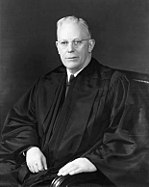 | Governor of California (1943–1953) California Attorney General (1939–1943) District Attorney of Alameda County (1925–1939) |  California California | Announced: November 1951 (Campaign) | |
 | President of the University of Pennsylvania (1948–1953) Governor of Minnesota (1939–1943) |  Pennsylvania Pennsylvania | (Campaign) | |
 | General of the Army (1944–1964) Commander of the United Nations Command and Governor of the Ryukyu Islands (1950–1951) Commander of the Far East Command (1947–1951) |  New York New York | ||
Favorite sons
The following candidates ran only in their home state's primary or caucus for the purpose of controlling its delegate slate at the convention and did not appear to be considered national candidates by the media.
- Businessman Riley A. Bender of Illinois
- Governor George Theodore Mickelson of South Dakota (Eisenhower surrogate)
- Senator Wayne Morse of Oregon
- Representative Thomas H. Werdel of California (Taft surrogate)
Declined to run
The following persons were listed in two or more major national polls or were the subject of media speculation surrounding their potential candidacy, but declined to actively seek the nomination.
- Senator John W. Bricker of Ohio (ran for re-election)
- Governor Thomas E. Dewey of New York (endorsed Eisenhower)
- Governor Alfred E. Driscoll of New Jersey (endorsed Eisenhower)[11]
- Senator James H. Duff of Pennsylvania (endorsed Eisenhower)
- Senator Henry Cabot Lodge Jr. of Massachusetts (endorsed Eisenhower)
- House Minority Leader Joseph W. Martin Jr. of Massachusetts
- Senator Arthur Vandenberg of Michigan (died April 18, 1951)
- Senator Kenneth S. Wherry of Nebraska
Polling
National polling
| Poll source | Publication | Thomas Dewey | Dwight Eisenhower | Douglas MacArthur | Harold Stassen | Robert Taft | Earl Warren | Other | Undecided/None |
|---|---|---|---|---|---|---|---|---|---|
| Gallup[12][a] | July 17, 1949 | 20% | 21% | 13% | 21% | 12% | 9% | 16%[b] | 5% |
| Gallup[13] | Nov. 6, 1949 | 12% | 25% | – | 19% | 15% | 10% | 13%[c] | 6% |
| Gallup[14] | Apr. 5, 1950 | 15% | 37% | – | 12% | 17% | 5% | 9%[d] | 8% |
| Gallup[15] | Sep. 26, 1950 | 14% | 42% | – | 14% | 15% | 6% | 3%[e] | 6% |
| Gallup[16] | Dec. 16, 1950 | 16% | 35% | – | 8% | 24% | 10% | 2% | 5% |
| Gallup[17] | Apr. 13, 1951 | 14% | 38% | – | 9% | 22% | 10% | 3%[f] | 4% |
| Gallup | May 1951 | 30% | – | 10% | 22% | 13% | |||
| Gallup[18] | Dec. 23, 1951 | 9% | 30% | 14% | 3% | 28% | 11% | 3% | 2% |
| 9% | – | 21% | 6% | 34% | 19% | 7% | 4% | ||
| 11% | 35% | – | 3% | 32% | 13% | 4% | 2% | ||
| Gallup[19] | Feb. 12, 1952 | 5% | 33% | 14% | 5% | 33% | 8% | – | 2% |
| Gallup[20] | Mar. 2, 1952 | 5% | 33% | 14% | 6% | 34% | 6% | – | 2% |
| Gallup[21] | Apr. 8, 1952 | 3% | 37% | 12% | 4% | 34% | 9% | – | 1% |
| Gallup[22] | May 1, 1952 | 3% | 44% | 10% | 3% | 33% | 6% | – | 1% |
| Gallup[23] | June 4, 1952 | 2% | 43% | 9% | 3% | 36% | 6% | – | 1% |
| Gallup[24] | June 21, 1952 | – | 44% | 10% | 3% | 35% | 7% | – | 1% |
| Gallup[25] | July 1, 1952 | – | 46% | 10% | 3% | 35% | 5% | – | 1% |
Primary campaign
March 11: New Hampshire primary
In late 1951, Eisenhower supporters increased their efforts to draft the general by establishing a campaign organization in New Hampshire, the first state to hold a popular election for delegates. Governor Sherman Adams endorsed the effort and became the New Hampshire campaign manager for the Draft Eisenhower campaign.[26] On January 6, at the same press conference revealing Eisenhower was a Republican, Senator Lodge formally submitted the general's name in the New Hampshire primary. The draft movement soon gained the endorsement of twenty-four newspapers, led by The New York Times.[27] A Draft Eisenhower rally at Madison Square Garden on February 8 drew a crowd far larger than the arena's capacity; shortly after, Eisenhower privately affirmed that he would contest the presidency, if nominated by the Republicans.[28][29]
On March 11, Eisenhower won the New Hampshire primary over Taft by a margin of 12 percent, sweeping all fourteen delegates.
However, from there until the Republican Convention the primaries were divided fairly evenly between the two men, and by the time the convention opened the race for the nomination was still too close to call.
Statewide contests by winner
Statewide contest won by candidates[30]
| Date | Pledged delegates | Contest | Robert A. Taft | Dwight Eisenhower | Harold Stassen | Earl Warren | Douglas MacArthur | Other/Uncommitted |
|---|---|---|---|---|---|---|---|---|
| March 11 | 14 | New Hampshire primary[31][32] | 38.59% | 14 50.25% | 7.08% | - | 3.48% | 0.6% |
| March 18 | 28 | Minnesota | 8.22% | 4 37.07% | 24 44.23% | 1.83% | 0.47% | 8.18% |
| April 1 | Nebraska | 36.33% | 30.15% | 24.29% | 0.85% | 3.41% | 4.97% | |
| 30 | Wisconsin | 24 40.63% | - | 21.85% | 6 33.77% | - | 3.75% | |
| April 8 | 0 | Illinois | 73.56% | 11.59% | 12.19% | 0.22% | 0.59% | 1.85% |
| April 15 | 0 | New Jersey | 35.54% | 60.64% | 3.66% | 0.07% | 0.10% | - |
| April 22 | Pennsylvania | 15.23% | 73.62% | 10.25% | 0.27% | 0.51% | 0.12% | |
| April 29 | Massachusetts | 29.69% | 68.68% | 0.29% | 0.41% | 0.61% | 0.32% | |
| May 6 | 56 | Ohio | 56 78.79% | - | 21.21% | - | - | - |
| May 13 | West Virginia | 78.52% | - | 21.48% | - | - | - | |
| May 16 | Oregon | 6.74% | 64.55% | 2.47% | 16.48% | 6.96% | 3.80%[a] | |
| June 3 | California | 33.61%[b] | - | - | 66.39% | - | - | |
| South Dakota | 50.32% | 49.68%[c] | - | - | - | - |
Italics indicate a write-in candidacy.
Total popular vote results
Primaries total popular vote results:[33]
- Robert A. Taft - 2,794,736 (35.84%)
- Dwight D. Eisenhower - 2,050,708 (26.30%)
- Earl Warren - 1,349,036 (17.30%)
- Harold Stassen - 881,702 (11.31%)
- Thomas H. Werdel - 521,110 (6.68%)
- George T. Mickelson - 63,879 (0.82%)
- Douglas MacArthur - 44,209 (0.57%)
- Grant A. Ritter - 26,208 (0.34%)
- Edward C. Slettedahl - 22,712 (0.29%)
- Riley A. Bender - 22,321 (0.29%)
- Mary E. Kenny - 10,411 (0.13%)
- Wayne L. Morse - 7,105 (0.09%)
- Perry J. Stearns - 2,925 (0.04%)
- William R. Schneider - 580 (0.01%)
Republican National Convention
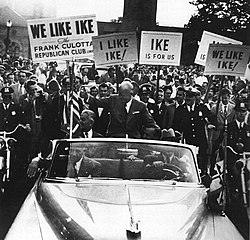
When the 1952 Republican National Convention opened in Chicago, most political experts rated Taft and Eisenhower as neck-and-neck in the delegate vote totals. Eisenhower's managers, led by Governor Dewey and Massachusetts Senator Henry Cabot Lodge Jr., accused Taft of "stealing" delegate votes in Southern states such as Texas and Georgia. They claimed that Taft's leaders in these states had illegally refused to give delegate spots to Eisenhower supporters and put Taft delegates in their place. Lodge and Dewey proposed to evict the pro-Taft delegates in these states and replace them with pro-Eisenhower delegates; they called this proposal "Fair Play". Although Taft and his supporters angrily denied this charge, the convention voted to support Fair Play 658–548, and Taft lost many Southern delegates; this decided the nomination in Eisenhower's favor. However, the mood at the convention was one of the most bitter and emotional in American history; in one speech Senator Everett Dirksen of Illinois, a Taft supporter, pointed at Governor Dewey on the convention floor and accused him of leading the Republicans "down the road to defeat", and mixed boos and cheers rang out from the delegates. In the end Eisenhower took the nomination on the first ballot; to heal the wounds caused by the battle he went to Taft's hotel suite and met with him. The Convention then chose young Senator Richard Nixon of California as Eisenhower's running mate; it was felt that Nixon's credentials as a slashing campaigner and anti-Communist would be valuable. Most historians now believe that Eisenhower's nomination was primarily due to the feeling that he was a "sure winner" against the Democrats; most of the delegates were conservatives who would probably have supported Taft if they felt he could have won the general election. The balloting at the Republican Convention went: (Richard C. Bain and Judith H. Parris, Convention Decisions and Voting Records, pp. 280–286):
| Presidential Balloting, RNC 1952 | ||
| Contender: Ballot | 1st Before Shifts | 1st After Shifts |
|---|---|---|
| General Dwight D. Eisenhower | 595 | 845 |
| Ohio Senator Robert A. Taft | 500 | 280 |
| Governor Earl Warren of California | 81 | 77 |
| Former Minnesota Governor Harold Stassen | 20 | 0 |
| General Douglas MacArthur | 10 | 4 |
Freshman California Senator Richard Nixon was nominated for Vice President, also with notable Dewey's support. Republican politicians thought that his political experience, aggressive style (he was known as strongly anti-communist) and political base on the West would help political newcomer Eisenhower.[34]
Endorsements
- Mark Hatfield,[35] U.S. Senator from Oregon
- Herbert Hoover,[33] former President of the United States
- Zora Neale Hurston, author
- Murray Rothbard,[33] Austrian school economist
See also
Notes
References
Bibliography
- Ambrose, Stephen E. (1983). Eisenhower. Vol. One. Simon & Schuster. ISBN 978-0-671-44069-5. LCCN 83009892. OL 3167850M. Retrieved December 10, 2021 – via Open Library.
- Baime, A. J. (2020). Dewey Defeats Truman – The 1948 Election and the Battle for America's Soul. Houghton Mifflin Harcourt. ISBN 978-1-328-58506-6. OL 29821320M.
- Beschloss, Michael R.; Virga, Vincent (1990). Eisenhower – A Centennial Life. HarperCollins. ISBN 978-0-06-016418-8. LCCN 89046225. OL 2219098M. Retrieved December 10, 2021 – via Open Library.
- Birkner, Michael J. (2003). "'He's My Man' – Sherman Adams and New Hampshire's Role in the 'Draft Eisenhower' Movement". Historical New Hampshire. 58: 5–25. ISSN 0018-2508. Archived from the original on January 11, 2019. Retrieved December 10, 2021 – via Gettysburg College.
- Busch, Andrew (2012). Truman's Triumphs – The 1948 Election and the Making of Postwar America. University Press of Kansas. ISBN 978-0-7006-1866-8. LCCN 2012020593. OL 26379614M. Retrieved December 10, 2021 – via Open Library.
- Daniel, Douglass K (2000). "They Liked Ike: Pro-Eisenhower Publishers and His Decision to Run for President". Journalism & Mass Communication Quarterly. 77 (2). Association for Education in Journalism and Mass Communication: 393–404. doi:10.1177/107769900007700211. ISSN 1077-6990. S2CID 144712540.
- Dishman, Robert B. (1953). "How It All Began – The Eisenhower Pre-Convention Campaign in New Hampshire, 1952". The New England Quarterly. 26 (1): 3–26. doi:10.2307/362333. JSTOR 362333.
- Eisenhower, Dwight D. (1981). Ferrell, Robert H. (ed.). The Eisenhower Diaries. W. W. Norton & Company. ISBN 978-0-393-33180-6. Retrieved December 10, 2021 – via Open Library.
- Frank, Jeffrey (2013). Ike and Dick – Portrait of a Strange Political Marriage. Simon & Schuster. ISBN 978-1-4165-8701-9. LCCN 2012015138. OL 25290770M. Retrieved December 10, 2021 – via Open Library.
- Gilbert, Robert E. (2008). "Eisenhower's 1955 Heart Attack: Medical Treatment, Political Effects, and the 'Behind the Scene' Leadership Style". Politics and the Life Sciences. 27 (1). Cambridge University Press: 2–21. doi:10.2990/27_1_2. JSTOR 40072943. PMID 19213302. S2CID 19518699.
- Greenstein, Fred I. (1982). The Hidden-Hand Presidency – Eisenhower as Leader. Basic Books. ISBN 978-0-465-02948-8. LCCN 82070847. OL 3511120M. Retrieved December 10, 2021 – via Open Library.
- Griffith, Robert (1970). "The General and the Senator – Republican Politics and the 1952 Campaign in Wisconsin". Wisconsin Magazine of History. Vol. 54, no. 1. Wisconsin Historical Society. pp. 23–29. JSTOR 4634580.
- Immerman, Richard H. (1999). John Foster Dulles – Piety, Pragmatism, and Power in U.S. Foreign Policy. Scholarly Resources. ISBN 978-0-8420-2601-7.
- Karabell, Zachary (2001). The Last Campaign – How Harry Truman Won the 1948 Election. Doubleday. ISBN 978-0-307-42886-8. OL 7426117M. Retrieved December 10, 2021 – via Open Library.
- Keefer, Edward C. (1986). "President Dwight D. Eisenhower and the End of the Korean War". Diplomatic History. 10 (3). Oxford University Press: 267–289. doi:10.1111/j.1467-7709.1986.tb00461.x. JSTOR 24911673.
- Lemelin, Bernard (2001). "The U.S. Presidential Election of 1948 – The Causes of Truman's 'Astonishing' Victory". Revue française d'études américaines. 87: 38–61. doi:10.3917/rfea.087.0038. ISSN 0397-7870. Archived from the original on December 10, 2021. Retrieved December 10, 2021 – via Cairn.info.
- Mason, Robert (2013). "Citizens For Eisenhower and the Republican Party, 1951–1965" (PDF). The Historical Journal. 56 (2). Cambridge University Press: 513–536. doi:10.1017/S0018246X12000593. S2CID 54894636.
- McCullough, David (1992). Truman. Simon & Schuster. ISBN 978-0-671-86920-5. LCCN 92005245. OL 1704072M. Retrieved December 10, 2021 – via Open Library.
- Morris, Kenneth E.; Schwartz, Barry (1993). "Why They Liked Ike – Tradition, Crisis, and Heroic Leadership". The Sociological Quarterly. 34 (1). Midwest Sociological Society: 131–151. doi:10.1111/j.1533-8525.1993.tb00134.x. JSTOR 4121562.
- Pach, Chester J.; Richardson, Elmo (1991). The Presidency of Dwight D. Eisenhower (Revised ed.). University Press of Kansas. ISBN 978-0-7006-0436-4. LCCN 90045952. OL 1884970M. Retrieved December 10, 2021 – via Open Library.
- Parmet, Herbert S. (1977). The Democrats – The Years After FDR. Oxford University Press. ISBN 978-0-19-519971-0. Retrieved December 10, 2021 – via Open Library.
- Patterson, James T. (1972). Mr. Republican: A Biography of Robert A. Taft. Boston, Houghton Mifflin. ISBN 9780395139387.
- Pickett, William B. (2000). Eisenhower Decides to Run: Presidential Politics and Cold War Strategy. Ivan R. Dee. ISBN 9781566633253. Retrieved December 30, 2021 – via Open Library.
- Pusey, Merlo J. (1956). Eisenhower – The President. Macmillan Publishers. Retrieved December 10, 2021 – via Open Library.
- Guide to U.S. Elections (6th ed.). SAGE Publications. 2010. ISBN 978-1-60426-536-1. LCCN 2009033938.
- Scheele, Henry Z. (1987). "The 1956 Nomination of Dwight D. Eisenhower – Maintaining the Hero Image". Presidential Studies Quarterly. 17 (3). Center for the Study of the Presidency and Congress: 459–471. JSTOR 27550439.
- Smith, Jean Edward (1990). Lucius D. Clay – An American life. Henry Holt and Company. ISBN 978-0-8050-0999-6. LCCN 89024720. OL 2202950M. Retrieved December 10, 2021 – via Open Library.
- Smith, Jean Edward (2012). Eisenhower in War and Peace. Penguin Random House LLC. ISBN 978-0-679-64429-3.
